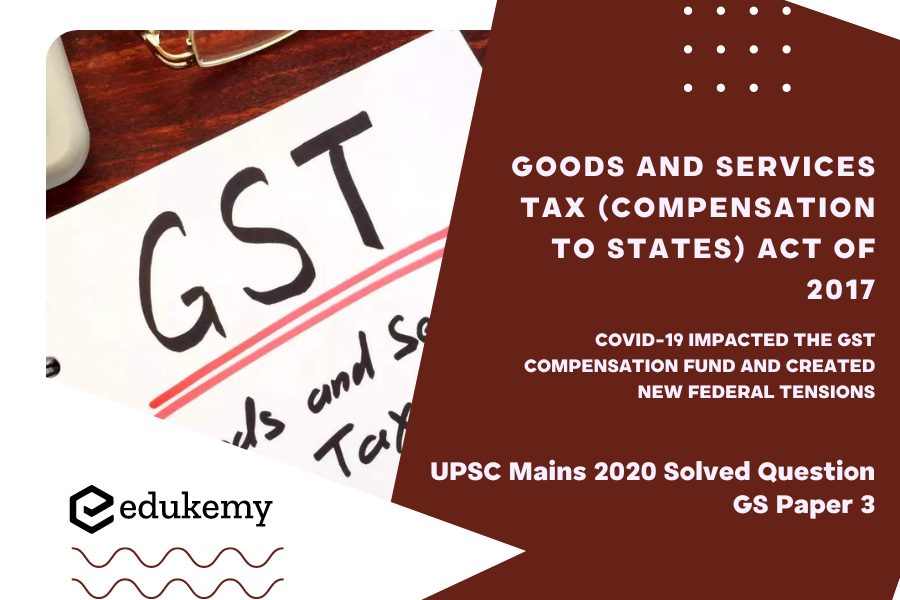
The Goods and Services Tax (Compensation to States) Act of 2017 was enacted in India to address the concerns of states regarding potential revenue losses resulting from the implementation of the Goods and Services Tax (GST). The GST, introduced to streamline the indirect tax system, replaced various state and central taxes. Recognizing that some states might experience shortfalls in revenue during the initial years of GST implementation, the Compensation to States Act aimed to provide financial assistance and ensure that no state suffered undue losses. However, the emergence of the COVID-19 pandemic in 2019 significantly disrupted economic activities, leading to unforeseen challenges for the GST compensation fund. The pandemic-induced economic downturn strained the fund as tax collections dwindled, intensifying fiscal pressures on both the central and state governments. This has sparked new federal tensions, as states grapple with reduced revenues, demanding compensation, and the central government faces fiscal constraints in meeting these obligations amidst the broader economic challenges posed by the pandemic.
UPSC Mains General Studies Paper – 3 Mains 2020
Indian economy and issues related to planning, mobilization of resources, growth development and employment. Inclusive growth and issues arising from it. Government budgeting.
UPSC Mains Civil Services IAS Exam Question Paper – 2020
Decoding the Question
- In the Introduction, start with writing about GST compensation.
- Body
- Explain the rationale behind the GST Compensation Act 2017
- Discuss how COVID-19 impacted the GST compensation fund and gave rise to new federal tensions.
- Try to conclude with suggestions and how to strengthen fiscal federalism.
Answer
Introduction
The GST (Compensation to the States) Act 2017, provides for compensation to the states for loss of revenue arising on account of the implementation of the goods and services tax for five years as per section 18 of the Constitution (101st Amendment) Act, 2016. It calls for compensation by the center to the states upon a 14% or more shortfall of revenue under GST till June 2022.
The rationale behind the GST Compensation Act 2017:
- Compensation for manufacturing states: States like Maharashtra, Gujarat, and Tamil Nadu lost a portion of their revenue as GST is a consumption tax, and thus the tax amount goes to the state of consumption rather than the manufacturing state as earlier.
- To meet the Revenue Shortfall of States: GST was introduced as one nation one tax by integrating the indirect taxation system of the country. This compensation fund was created by imposing a concession cess on demerit goods.
- Creating constitutional liability: The Act created a constitutionally binding agreement between the center and the state regarding GST compensation.
- Fixed Revenue Growth: The Centre had assured 14% year-on-year GST revenue growth for 5 years. If such an amount is not available then the Centre will compensate the State for such deficiency.
- Meeting the Actual Revenue Targets of the state: The total compensation payable in any financial year shall be the difference between the projected revenue for any financial year and the actual revenue collected by a state. This is done through the GST compensation corpus fund created for it.
How Covid-19 impacted GST compensation fund and gave rise to New federal tension:
For the 2020-21 fiscal year, the revenue shortfall has been anticipated at ₹3 lakh crore, with the Compensation Fund expected to have only about ₹65,000 crores through cess accruals and balance to pay the compensation to the States.
- Lower tax collection for states: The slide in economic activities due to the imposition of localized lockdowns to deal with the second wave of COVID-19 is likely to further strain the fiscal position of state governments.
- The gap in financing vaccines: While economic activity is slow, the vaccination drive gathers momentum. According to an estimate it can gulp up as much as 30% of the state’s revenues.
- Bypassing of Council: The GST Council would have been expected to provide a forum to discuss and debate solutions to the compensation crisis. Instead, what was seen was that the Union tried to bypass the council.
- States rejected the Market Borrowing Mechanism: many states like W. Bengal, Kerala, Punjab, etc. are against market borrowings and asking the Centre to fulfill the constitutional obligation. The GST Act and Compensation Act made it clear that the revenue shortfall of states will have to be compensated by the Centre under the agreement.
- Supreme Court’s Intervention: Opposition party-ruled states moved to the Supreme Court against the Centre’s move to break down constitutional/federal agreements.
- Non-Uniform Impact: Considering that the virus spread and lockdown restrictions have varied across states, the loss across states may not be uniform.
Way Forward:
- It is time for states to accept the realities and agree to a lower level of compensation, ideally linked to the growth rate of the Indian economy in nominal terms.
- States can’t turn a blind eye to the aftermath of the pandemic.
- The Union government must also need to lead the country out of its GST impasse by borrowing more from financial markets or directly from RBI.
- The Centre must understand that it is their statutory obligation and they can’t abrogate it.
- States should reciprocate by settling for a more realistic compensation for the time being while exploring the options suggested by the Centre.
Conclusion
In this context, the present regime of the GST compensation act guaranteeing revenue growth to the tune of 14% may be unreasonable. Linking it to nominal GDP growth may be a better alternative. The Centre should focus on its constitutional obligation and give States their due share of revenue by borrowing from the market. Therefore, Covid-19 has created federal-economic issues and these issues should be handled in the prudence of constitutional wisdom the Centre should allow States to raise money by imposing cess in their respective domain.
Frequently Asked Questions (FAQs)
FAQ 1: Explain the rationale behind the Goods and Services Tax (Compensation to States) Act of 2017.
A: The Goods and Services Tax (GST) was introduced in India on July 1, 2017, to create a unified and simplified indirect tax structure across the country. The GST subsumed various central and state taxes, fostering a common market and reducing the cascading effects of taxes. However, the implementation of GST posed challenges for states as they were concerned about potential revenue losses due to the dismantling of the earlier tax regime.
To address these concerns and to ensure that no state faced a significant revenue shortfall during the initial years of GST implementation, the Goods and Services Tax (Compensation to States) Act was enacted in 2017. The Act mandated that if a state’s revenue growth from GST fell below a certain agreed-upon benchmark for a specific period, the central government would compensate the state for the shortfall. This compensation was to be funded through the GST Compensation Cess levied on certain goods and services.
The rationale behind the Act was to provide financial support to states during the transition period, ensuring that they did not incur substantial revenue losses due to the introduction of GST. This mechanism aimed to maintain fiscal stability for states and encourage them to actively participate in the GST framework.
FAQ 2: How has COVID-19 impacted the GST compensation fund and created new federal tensions?
A: The COVID-19 pandemic had a profound impact on the global economy, and India was no exception. The lockdowns and economic disruptions resulted in reduced economic activities, leading to a decline in tax collections, including GST. As a consequence, the GST compensation fund faced challenges due to lower-than-expected revenue collections.
The pandemic-induced economic downturn led to a situation where states faced a double whammy – reduced GST collections and increased expenditure on healthcare and relief measures. With the compensation fund under stress, there were concerns about the central government’s ability to fulfill its commitment to compensate states for revenue shortfalls.
The situation created tensions between the central and state governments, with states seeking more financial support to cope with the extraordinary circumstances brought about by the pandemic. There were debates on the mode of compensation and the duration for which it should be provided. Some states argued for an extension of the compensation period beyond the initially agreed-upon five years.
These tensions highlighted the challenges of maintaining fiscal federalism during unprecedented crises and raised discussions on reevaluating the fiscal architecture to better prepare for future shocks. The negotiations and discussions between the central and state governments during this period underscored the need for a collaborative and adaptable approach in the face of unforeseen challenges.

For UPSC Prelims Resources, Click here
For Daily Updates and Study Material:
Join our Telegram Channel – Edukemy for IAS
- 1. Learn through Videos – here
- 2. Be Exam Ready by Practicing Daily MCQs – here
- 3. Daily Newsletter – Get all your Current Affairs Covered – here
- 4. Mains Answer Writing Practice – here
Visit our YouTube Channel – here

